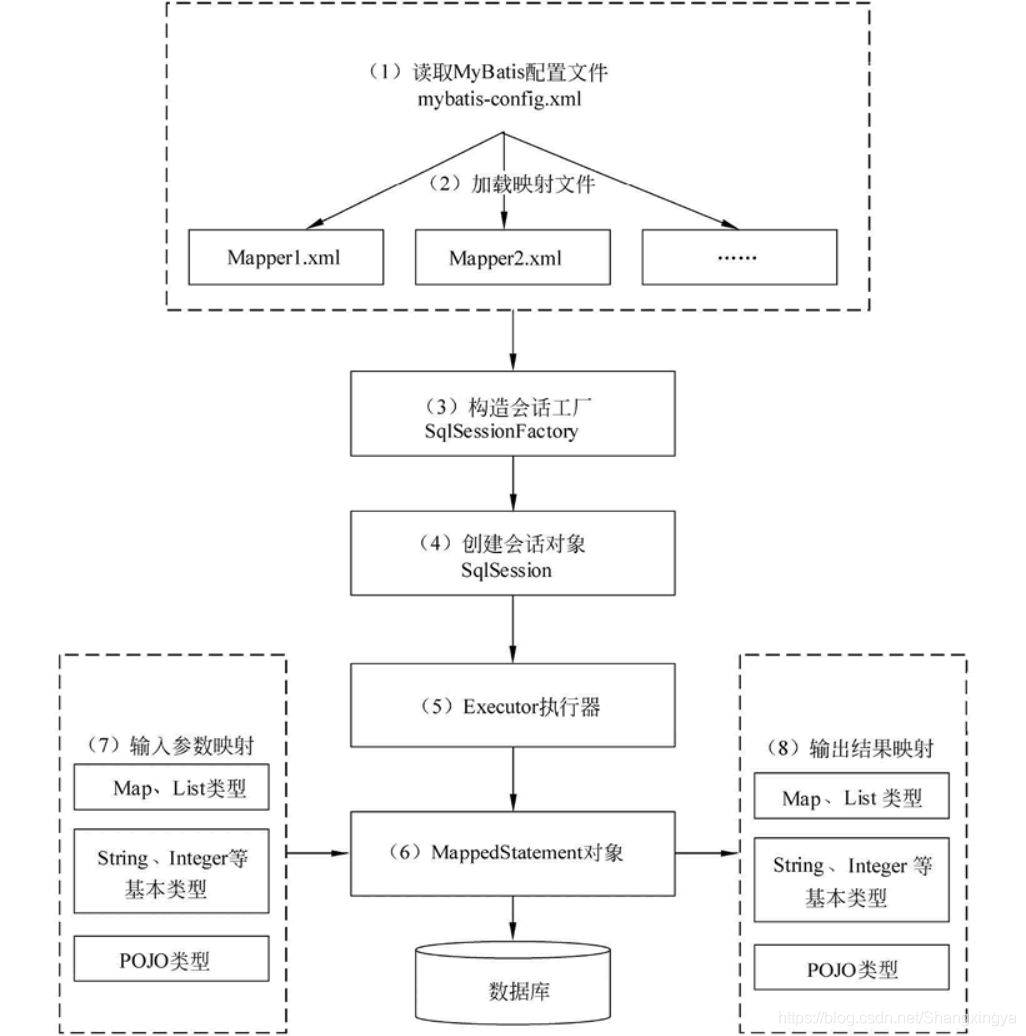жӮЁеҘҪпјҢзҷ»еҪ•еҗҺжүҚиғҪдёӢи®ўеҚ•е“ҰпјҒ
жӮЁеҘҪпјҢзҷ»еҪ•еҗҺжүҚиғҪдёӢи®ўеҚ•е“ҰпјҒ
MyBatis
MyBatisе’Ңhibernateзҡ„еҢәеҲ«жңүе“Әдәӣ
йҰ–е…ҲиҰҒзҹҘйҒ“ORMжЎҶжһ¶, з®ҖеҚ•жқҘиҜҙе°ұжҳҜйҖҡиҝҮе®һдҫӢеҜ№иұЎзҡ„иҜӯжі•, е®ҢжҲҗе…ізі»еһӢж•°жҚ®еә“зҡ„ж“ҚдҪңзҡ„дёҖз§ҚжЎҶжһ¶, жҳҜ еҜ№иұЎ-е…ізі» жҳ е°„, д№ҹе°ұжҳҜжҠҠж•°жҚ®еә“жҳ е°„жҲҗеҜ№иұЎ

ејҖеҸ‘ж–№йқў
sql дјҳеҢ–ж–№йқў
дёҚеҗҢдјҳеҠҝ
е®һзҺ°иҝҮзЁӢ

1пјүиҜ»еҸ– MyBatis й…ҚзҪ®ж–Ү件пјҡmybatis-config.xml дёә MyBatis зҡ„е…ЁеұҖй…ҚзҪ®ж–Ү件пјҢй…ҚзҪ®дәҶ MyBatis зҡ„иҝҗиЎҢзҺҜеўғзӯүдҝЎжҒҜпјҢдҫӢеҰӮж•°жҚ®еә“иҝһжҺҘдҝЎжҒҜгҖӮ
2пјүеҠ иҪҪжҳ е°„ж–Ү件гҖӮжҳ е°„ж–Ү件еҚі SQL жҳ е°„ж–Ү件пјҢиҜҘж–Ү件дёӯй…ҚзҪ®дәҶж“ҚдҪңж•°жҚ®еә“зҡ„ SQL иҜӯеҸҘпјҢйңҖиҰҒеңЁ MyBatis й…ҚзҪ®ж–Ү件 mybatis-config.xml дёӯеҠ иҪҪгҖӮmybatis-config.xml ж–Ү件еҸҜд»ҘеҠ иҪҪеӨҡдёӘжҳ е°„ж–Ү件пјҢжҜҸдёӘж–Ү件еҜ№еә”ж•°жҚ®еә“дёӯзҡ„дёҖеј иЎЁгҖӮ
3пјүжһ„йҖ дјҡиҜқе·ҘеҺӮпјҡйҖҡиҝҮ MyBatis зҡ„зҺҜеўғзӯүй…ҚзҪ®дҝЎжҒҜжһ„е»әдјҡиҜқе·ҘеҺӮ SqlSessionFactoryгҖӮ
4пјүеҲӣе»әдјҡиҜқеҜ№иұЎпјҡз”ұдјҡиҜқе·ҘеҺӮеҲӣе»ә SqlSession еҜ№иұЎпјҢиҜҘеҜ№иұЎдёӯеҢ…еҗ«дәҶжү§иЎҢ SQL иҜӯеҸҘзҡ„жүҖжңүж–№жі•гҖӮ
5пјүExecutor жү§иЎҢеҷЁпјҡMyBatis еә•еұӮе®ҡд№үдәҶдёҖдёӘ Executor жҺҘеҸЈжқҘж“ҚдҪңж•°жҚ®еә“пјҢе®ғе°Ҷж №жҚ® SqlSession дј йҖ’зҡ„еҸӮж•°еҠЁжҖҒең°з”ҹжҲҗйңҖиҰҒжү§иЎҢзҡ„ SQL иҜӯеҸҘпјҢеҗҢж—¶иҙҹиҙЈжҹҘиҜўзј“еӯҳзҡ„з»ҙжҠӨгҖӮ
6пјүMappedStatement еҜ№иұЎпјҡеңЁ Executor жҺҘеҸЈзҡ„жү§иЎҢж–№жі•дёӯжңүдёҖдёӘ MappedStatement зұ»еһӢзҡ„еҸӮж•°пјҢиҜҘеҸӮж•°жҳҜеҜ№жҳ е°„дҝЎжҒҜзҡ„е°ҒиЈ…пјҢз”ЁдәҺеӯҳеӮЁиҰҒжҳ е°„зҡ„ SQL иҜӯеҸҘзҡ„ idгҖҒеҸӮж•°зӯүдҝЎжҒҜгҖӮ
7пјүиҫ“е…ҘеҸӮж•°жҳ е°„пјҡиҫ“е…ҘеҸӮж•°зұ»еһӢеҸҜд»ҘжҳҜ MapгҖҒList зӯүйӣҶеҗҲзұ»еһӢпјҢд№ҹеҸҜд»ҘжҳҜеҹәжң¬ж•°жҚ®зұ»еһӢе’Ң POJO зұ»еһӢгҖӮиҫ“е…ҘеҸӮж•°жҳ е°„иҝҮзЁӢзұ»дјјдәҺ JDBC еҜ№ preparedStatement еҜ№иұЎи®ҫзҪ®еҸӮж•°зҡ„иҝҮзЁӢгҖӮ
8пјүиҫ“еҮәз»“жһңжҳ е°„пјҡиҫ“еҮәз»“жһңзұ»еһӢеҸҜд»ҘжҳҜ MapгҖҒ List зӯүйӣҶеҗҲзұ»еһӢпјҢд№ҹеҸҜд»ҘжҳҜеҹәжң¬ж•°жҚ®зұ»еһӢе’Ң POJO зұ»еһӢгҖӮиҫ“еҮәз»“жһңжҳ е°„иҝҮзЁӢзұ»дјјдәҺ JDBC еҜ№з»“жһңйӣҶзҡ„и§ЈжһҗиҝҮзЁӢгҖӮ
MyBatisеңЁSpring Bootдёӯзҡ„й…ҚзҪ®
<!-- =================иҰҒж·»еҠ зҡ„йғЁеҲҶејҖе§Ӣ================== -->
<dependency>
<groupId>org.mybatis.spring.boot</groupId>
<artifactId>mybatis-spring-boot-starter</artifactId>
<version>2.1.1</version>
</dependency>
<!-- Mybatisд»Јз Ғз”ҹжҲҗе·Ҙе…· -->
<dependency>
<groupId>org.mybatis.generator</groupId>
<artifactId>mybatis-generator-core</artifactId>
<version>1.3.5</version>
</dependency>
<!-- mysql-connector-java: mysqlж•°жҚ®еә“й©ұеҠЁеҢ…
еңЁзј–иҜ‘ж—¶жІЎжңүзӣҙжҺҘдҪҝз”ЁпјҢдҪҶжҳҜиҝҗиЎҢж—¶йңҖиҰҒпјҢжүҖд»ҘдҪҝз”Ё
scope runtime -->
<dependency>
<groupId>mysql</groupId>
<artifactId>mysql-connector-java</artifactId>
<version>5.1.47</version>
<scope>runtime</scope>
</dependency>
<!-- druid-spring-boot-starter: йҳҝйҮҢDruidж•°жҚ®еә“иҝһжҺҘжұ пјҢеҗҢж ·зҡ„иҝҗиЎҢж—¶йңҖиҰҒ -->
<dependency>
<groupId>com.alibaba</groupId>
<artifactId>druid-spring-boot-starter</artifactId>
<version>1.1.21</version>
</dependency>
<!-- =================иҰҒж·»еҠ зҡ„йғЁеҲҶз»“жқҹ================== -->
еңЁжәҗд»Јз Ғи·Ҝеҫ„дёӢеҲӣе»әGenerator
import org.mybatis.generator.api.MyBatisGenerator;
import org.mybatis.generator.config.Configuration;
import org.mybatis.generator.config.xml.ConfigurationParser;
import org.mybatis.generator.internal.DefaultShellCallback;
import java.io.File;
import java.io.InputStream;
import java.util.ArrayList;
import java.util.List;
public class Generator {
private static final boolean OVERWRITE = true;
private static final String CONFIG_PATH = "generator/config.xml";
public static void main(String[] args) throws Exception {
System.out.println("--------------------start generator-------------------");
System.out.println(new File("").getAbsolutePath());
List<String> warnings = new ArrayList<>();
ClassLoader classloader = Thread.currentThread().getContextClassLoader();
InputStream is = classloader.getResourceAsStream(CONFIG_PATH);
ConfigurationParser cp = new ConfigurationParser(warnings);
Configuration config = cp.parseConfiguration(is);
DefaultShellCallback callback = new DefaultShellCallback(OVERWRITE);
MyBatisGenerator myBatisGenerator = new MyBatisGenerator(config, callback, warnings);
myBatisGenerator.generate(null);
warnings.forEach(System.err::println);
System.out.println("--------------------end generator-------------------");
}
}
еңЁresourcesзӣ®еҪ•дёӢй…ҚзҪ®application.properties
#debug=true # и®ҫзҪ®жү“еҚ°ж—Ҙеҝ—зҡ„зә§еҲ«пјҢеҸҠжү“еҚ°sqlиҜӯеҸҘ logging.level.root=ERROR logging.level.druid.sql.Statement=ERROR logging.level.frank=DEBUG # зҫҺеҢ–JSONж•°жҚ®ж јејҸ spring.jackson.serialization.indent-output=true # и®ҫзҪ®JSONж•°жҚ®зҡ„ж—Ҙжңҹж јејҸ spring.jackson.date-format=yyyy-MM-dd HH:mm:ss spring.jackson.time-zone=GMT+8 # JSONж•°жҚ®еұһжҖ§дёәnullж—¶дёҚиҝ”еӣһ spring.jackson.default-property-inclusion=non_null # жүҫдёҚеҲ°иө„жәҗ404ж—¶жҠӣеҮәејӮеёё spring.mvc.throw-exception-if-no-handler-found=true # зҰҒз”ЁйқҷжҖҒиө„жәҗзҡ„иҮӘеҠЁжҳ е°„пјҢеҰӮдёҚзҰҒз”ЁпјҢдёҚеӯҳеңЁзҡ„urlе°Ҷиў«жҳ е°„еҲ°/**пјҢservletдёҚжңүжңәдјҡжҠӣеҮәејӮеёё #spring.resources.add-mappings=false # getиҜ·жұӮеҸӮж•°еҸҠиЎЁеҚ•жҸҗдәӨж•°жҚ®зҡ„ж—Ҙжңҹж јејҸ spring.mvc.date-format=yyyy-MM-dd HH:mm:ss # еә”з”Ё/йЎ№зӣ®зҡ„йғЁзҪІи·Ҝеҫ„пјҢй»ҳи®Өдёә/ #server.servlet.context-path=/lucky-draw # SpringMVCдёӯпјҢDispatcherServletзҡ„жҳ е°„и·Ҝеҫ„пјҢй»ҳи®Өдёә/** #spring.mvc.servlet.path=/** # йқҷжҖҒиө„жәҗжҳ е°„пјҡе°Ҷи·Ҝеҫ„жҳ е°„дёә/пјҢеҚі/static/xxxпјҢжҳ е°„дёә/xxxпјҢж”ҜжҢҒеӨҡдёӘеӯ—з¬ҰдёІпјҢйҖ—еҸ·й—ҙйҡ” # й»ҳи®Өдёә/META-INF/resources/, /resources/, /static/, /public/ #spring.resources.static-locations=/static/,/public/ #====================иҰҒж №жҚ®е…·дҪ“ж•°жҚ®еә“й…ҚзҪ®......зҡ„йғЁеҲҶејҖе§Ӣ==================== #druidж•°жҚ®еә“иҝһжҺҘжұ й…ҚзҪ® spring.datasource.driver-class-name=com.mysql.jdbc.Driver spring.datasource.url=jdbc:mysql://localhost:3306/......?useUnicode=true&characterEncoding=utf8&autoReconnect=true&failOverReadOnly=false spring.datasource.username=root spring.datasource.password=...... spring.datasource.druid.initial-size=1 spring.datasource.druid.min-idle=1 spring.datasource.druid.max-active=20 spring.datasource.druid.test-on-borrow=true #Mybatisй…ҚзҪ® mybatis.mapper-locations=classpath:mapper/**Mapper.xml #mybatis.type-aliases-package=frank.mapper mybatis.configuration.map-underscore-to-camel-case=true #mybatis.config-location=classpath:mybatis/mybatis-config.xml #====================иҰҒж №жҚ®е…·дҪ“ж•°жҚ®еә“й…ҚзҪ®......зҡ„йғЁеҲҶз»“жқҹ==================== ##mapper ##mappers еӨҡдёӘжҺҘеҸЈж—¶йҖ—еҸ·йҡ”ејҖ ##mapper.mappers=tk.mybatis.mapper.common.Mapper,tk.mybatis.mapper.common.MySqlMapper,tk.mybatis.mapper.common.IdsMapper ##mapper.notEmpty=true ##mapper.identity=MYSQL # ##pagehelper ##ж•°жҚ®еә“ж–№иЁҖпјҡoracle,mysql,mariadb,sqlite,hsqldb,postgresql,db2,sqlserver,informix,h3,sqlserver2012,derby #pagehelper.helperDialect=mysql ##й»ҳи®ӨеҖјдёә falseпјҢиҜҘеҸӮж•°еҜ№дҪҝз”Ё RowBounds дҪңдёәеҲҶйЎөеҸӮж•°ж—¶жңүж•ҲгҖӮ еҪ“иҜҘеҸӮж•°и®ҫзҪ®дёә true ж—¶пјҢдјҡе°Ҷ RowBounds дёӯзҡ„ offset еҸӮж•°еҪ“жҲҗ pageNum дҪҝз”ЁпјҢеҸҜд»Ҙз”ЁйЎөз Ғе’ҢйЎөйқўеӨ§е°ҸдёӨдёӘеҸӮж•°иҝӣиЎҢеҲҶйЎөгҖӮ ##pagehelper.offset-as-page-num=falses ##й»ҳи®ӨеҖјдёәfalseпјҢиҜҘеҸӮж•°еҜ№дҪҝз”Ё RowBounds дҪңдёәеҲҶйЎөеҸӮж•°ж—¶жңүж•ҲгҖӮ еҪ“иҜҘеҸӮж•°и®ҫзҪ®дёәtrueж—¶пјҢдҪҝз”Ё RowBounds еҲҶйЎөдјҡиҝӣиЎҢ count жҹҘиҜўгҖӮ #pagehelper.row-bounds-with-count=true ##й»ҳи®ӨеҖјдёә falseпјҢеҪ“иҜҘеҸӮж•°и®ҫзҪ®дёә true ж—¶пјҢеҰӮжһң pageSize=0 жҲ–иҖ… RowBounds.limit = 0 е°ұдјҡжҹҘиҜўеҮәе…ЁйғЁзҡ„з»“жһңпјҲзӣёеҪ“дәҺжІЎжңүжү§иЎҢеҲҶйЎөжҹҘиҜўпјҢдҪҶжҳҜиҝ”еӣһз»“жһңд»Қ然жҳҜ Page зұ»еһӢпјүгҖӮ ##pagehelper.page-size-zero=false ##еҲҶйЎөеҗҲзҗҶеҢ–еҸӮж•°пјҢй»ҳи®ӨеҖјдёәfalseгҖӮеҪ“иҜҘеҸӮж•°и®ҫзҪ®дёә true ж—¶пјҢpageNum<=0 ж—¶дјҡжҹҘиҜўз¬¬дёҖйЎөпјҢ pageNum>pagesпјҲи¶…иҝҮжҖ»ж•°ж—¶пјүпјҢдјҡжҹҘиҜўжңҖеҗҺдёҖйЎөгҖӮй»ҳи®Өfalse ж—¶пјҢзӣҙжҺҘж №жҚ®еҸӮж•°иҝӣиЎҢжҹҘиҜўгҖӮ #pagehelper.reasonable=true ##дёәдәҶж”ҜжҢҒstartPage(Object params)ж–№жі•пјҢеўһеҠ дәҶиҜҘеҸӮж•°жқҘй…ҚзҪ®еҸӮж•°жҳ е°„пјҢз”ЁдәҺд»ҺеҜ№иұЎдёӯж №жҚ®еұһжҖ§еҗҚеҸ–еҖјпјҢ еҸҜд»Ҙй…ҚзҪ® pageNum,pageSize,count,pageSizeZero,reasonableпјҢдёҚй…ҚзҪ®жҳ е°„зҡ„з”Ёй»ҳи®ӨеҖјпјҢ й»ҳи®ӨеҖјдёәpageNum=pageNum;pageSize=pageSize;count=countSql;reasonable=reasonable;pageSizeZero=pageSizeZeroгҖӮ #pagehelper.params=pageNum=pageNumber;pageSize=pageSize;count=countSql;reasonable=reasonable; ##ж”ҜжҢҒйҖҡиҝҮ Mapper жҺҘеҸЈеҸӮж•°жқҘдј йҖ’еҲҶйЎөеҸӮж•°пјҢй»ҳи®ӨеҖјfalseпјҢеҲҶйЎөжҸ’件дјҡд»ҺжҹҘиҜўж–№жі•зҡ„еҸӮж•°еҖјдёӯпјҢиҮӘеҠЁж №жҚ®дёҠйқў params й…ҚзҪ®зҡ„еӯ—ж®өдёӯеҸ–еҖјпјҢжҹҘжүҫеҲ°еҗҲйҖӮзҡ„еҖјж—¶е°ұдјҡиҮӘеҠЁеҲҶйЎөгҖӮ дҪҝз”Ёж–№жі•еҸҜд»ҘеҸӮиҖғжөӢиҜ•д»Јз Ғдёӯзҡ„ com.github.pagehelper.test.basic еҢ…дёӢзҡ„ ArgumentsMapTest е’Ң ArgumentsObjTestгҖӮ ##pagehelper.supportMethodsArguments=true ##з”ЁдәҺжҺ§еҲ¶й»ҳи®ӨдёҚеёҰ count жҹҘиҜўзҡ„ж–№жі•дёӯпјҢжҳҜеҗҰжү§иЎҢ count жҹҘиҜўпјҢй»ҳи®Ө true дјҡжү§иЎҢ count жҹҘиҜўпјҢиҝҷжҳҜдёҖдёӘе…ЁеұҖз”ҹж•Ҳзҡ„еҸӮж•°пјҢеӨҡж•°жҚ®жәҗж—¶д№ҹжҳҜз»ҹдёҖзҡ„иЎҢдёәгҖӮ #pagehelper.default-count=false
еңЁresourcesзӣ®еҪ•дёӢеҲӣе»әGeneratorеҢ…并且й…ҚзҪ®config.xmlж–Ү件
<?xml version="1.0" encoding="UTF-8"?>
<!DOCTYPE generatorConfiguration
PUBLIC "-//mybatis.org//DTD MyBatis Generator Configuration 1.0//EN"
"http://mybatis.org/dtd/mybatis-generator-config_1_0.dtd">
<generatorConfiguration>
<properties resource="application.properties" />
<context id="Mysql" targetRuntime="MyBatis3" defaultModelType="flat">
<property name="javaFileEncoding" value="UTF-8"/>
<commentGenerator>
<property name="suppressDate" value="true"/>
<property name="suppressAllComments" value="true" />
<property name="addRemarkComments" value="true"/>
</commentGenerator>
<jdbcConnection driverClass="${spring.datasource.driver-class-name}"
connectionURL="${spring.datasource.url}"
userId="${spring.datasource.username}"
password="${spring.datasource.password}">
<property name="useInformationSchema" value="true" />
</jdbcConnection>
<!-- й»ҳи®ӨfalseпјҢжҠҠJDBC DECIMAL е’Ң NUMERIC зұ»еһӢи§Јжһҗдёә IntegerпјҢ
дёә trueж—¶жҠҠJDBC DECIMAL е’Ң NUMERIC зұ»еһӢи§Јжһҗдёәjava.math.BigDecimal -->
<javaTypeResolver>
<property name="forceBigDecimals" value="false" />
</javaTypeResolver>
<!--MyBatis з”ҹжҲҗеҷЁеҸӘйңҖиҰҒз”ҹжҲҗ Model-->
<javaModelGenerator targetProject="дҝ®ж”№дёәиҮӘе·ұзҡ„йЎ№зӣ®еҗҚ/src/test/java"
targetPackage="дҝ®ж”№дёәе®һдҪ“зұ»зҡ„еҢ…(model,еңЁеҗҜеҠЁзұ»зҡ„ж №еҢ…дёӢ)">
<!-- <property name="rootClass" value="дҝ®ж”№дёәе®һдҪ“зұ»зҡ„зҲ¶зұ»"/>-->
</javaModelGenerator>
<!--mybatis зҡ„xmlж–Ү件ең°еқҖ-->
<sqlMapGenerator targetProject="дҝ®ж”№дёәиҮӘе·ұзҡ„йЎ№зӣ®еҗҚ/src/test/resources"
targetPackage="дҝ®ж”№дёәxmlзҡ„еҢ…(mapper)">
<property name="enableSubPackages" value="true"/>
</sqlMapGenerator>
<!--mybatisзҡ„mapperжҺҘеҸЈ-->
<javaClientGenerator type="XMLMAPPER"
targetProject="дҝ®ж”№дёәиҮӘе·ұзҡ„йЎ№зӣ®еҗҚ/src/test/java"
targetPackage="дҝ®ж”№дёәmapperзҡ„еҢ…(еңЁеҗҜеҠЁзұ»зҡ„ж №еҢ…дёӢ)">
<property name="enableSubPackages" value="true"/>
<!-- <property name="rootInterface" value="дҝ®ж”№дёәmapperзҡ„зҲ¶жҺҘеҸЈ"/>-->
</javaClientGenerator>
<!-- йңҖиҰҒз”ҹжҲҗзҡ„иЎЁпјҢ%иЎЁзӨәжЁЎзіҠеҢ№й…ҚпјҢд№ҹеҸҜд»ҘжҢҮе®ҡе…·дҪ“зҡ„иЎЁеҗҚ -->
<!-- <table tableName="%"-->
<!-- enableCountByExample="false"-->
<!-- enableDeleteByExample="false"-->
<!-- enableSelectByExample="false"-->
<!-- enableUpdateByExample="false"-->
<!-- >-->
<table tableName="%">
<!-- insertж–№жі•йҖҡиҝҮиҮӘеўһдё»й”®жҸ’е…Ҙж•°жҚ®еҗҺпјҢдё»й”®еҖјжҳҜеҗҰи®ҫзҪ®еҲ°еҜ№иұЎеұһжҖ§дёӯ -->
<!-- <generatedKey column="id" sqlStatement="JDBC"/>-->
<generatedKey column="id" sqlStatement="Mysql" identity="true" />
</table>
<!-- <table tableName="user">-->
<!-- <generatedKey column="id" sqlStatement="Mysql" identity="true" />-->
<!-- </table>-->
</context>
</generatorConfiguration>
еҰӮжһңдёҚзҹҘйҒ“и·Ҝеҫ„еҸҜд»ҘиҮӘе·ұжү“еҚ°дёҖдёӢеҪ“еүҚйЎ№зӣ®зҡ„з»қеҜ№и·Ҝеҫ„
import java.io.File;
/**
* Created with IntelliJ IDEA.
* Description: If you don't work hard, you will a loser.
* User: Listen-Y.
* Date: 2020-08-21
* Time: 17:41
*/
public class test {
public static void main(String[] args) {
//жү“еҚ°еҪ“еүҚйЎ№зӣ®зҡ„з»қеҜ№и·Ҝеҫ„
System.out.println(new File("").getAbsolutePath());
}
}
еңЁtestзӣ®еҪ•дёӢеҲӣе»әresourcesеҢ…

@MapperScan(basePackages = "еҗҜеҠЁзұ»зҡ„ж №еҢ…еҗҚ.mapper")
з»ҷmapperзҡ„жҜҸдёӘж–Ү件еўһеҠ жіЁи§Ј
@Mapper
жҖ»з»“
еҲ°жӯӨиҝҷзҜҮе…ідәҺJavaEE SpringMyBatisжҳҜд»Җд№Ҳ? е®ғе’ҢHibernateзҡ„еҢәеҲ«еҸҠеҰӮдҪ•й…ҚзҪ®MyBatisзҡ„ж–Үз« е°ұд»Ӣз»ҚеҲ°иҝҷдәҶ,жӣҙеӨҡзӣёе…іJavaEE Spring MyBatisжҳҜд»Җд№Ҳе®ғе’ҢHibernateзҡ„еҢәеҲ«еҶ…е®№иҜ·жҗңзҙўдәҝйҖҹдә‘д»ҘеүҚзҡ„ж–Үз« жҲ–继з»ӯжөҸи§ҲдёӢйқўзҡ„зӣёе…іж–Үз« еёҢжңӣеӨ§е®¶д»ҘеҗҺеӨҡеӨҡж”ҜжҢҒдәҝйҖҹдә‘пјҒ
е…ҚиҙЈеЈ°жҳҺпјҡжң¬з«ҷеҸ‘еёғзҡ„еҶ…е®№пјҲеӣҫзүҮгҖҒи§Ҷйў‘е’Ңж–Үеӯ—пјүд»ҘеҺҹеҲӣгҖҒиҪ¬иҪҪе’ҢеҲҶдә«дёәдё»пјҢж–Үз« и§ӮзӮ№дёҚд»ЈиЎЁжң¬зҪ‘з«ҷз«ӢеңәпјҢеҰӮжһңж¶үеҸҠдҫөжқғиҜ·иҒ”зі»з«ҷй•ҝйӮ®з®ұпјҡis@yisu.comиҝӣиЎҢдёҫжҠҘпјҢ并жҸҗдҫӣзӣёе…іиҜҒжҚ®пјҢдёҖз»ҸжҹҘе®һпјҢе°Ҷз«ӢеҲ»еҲ йҷӨж¶үе«ҢдҫөжқғеҶ…е®№гҖӮ